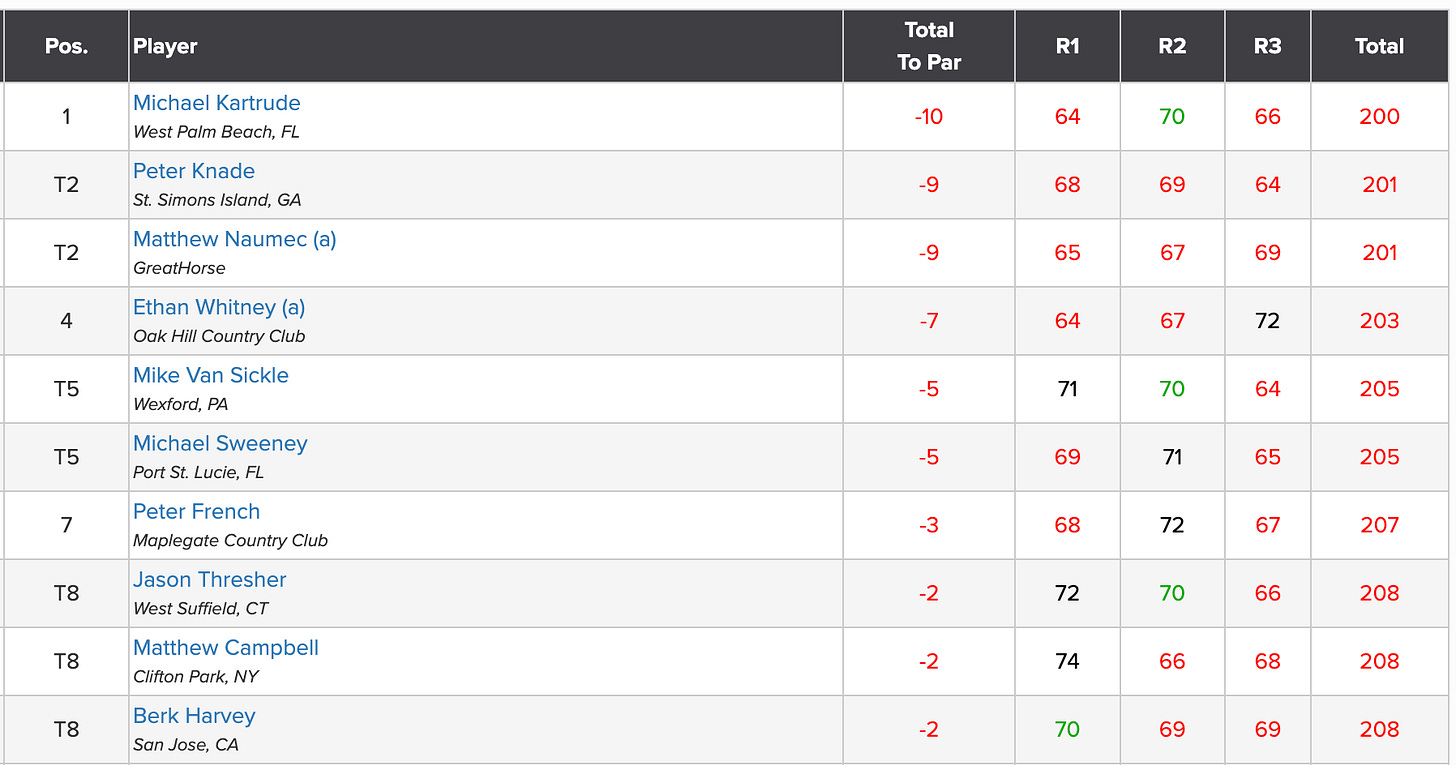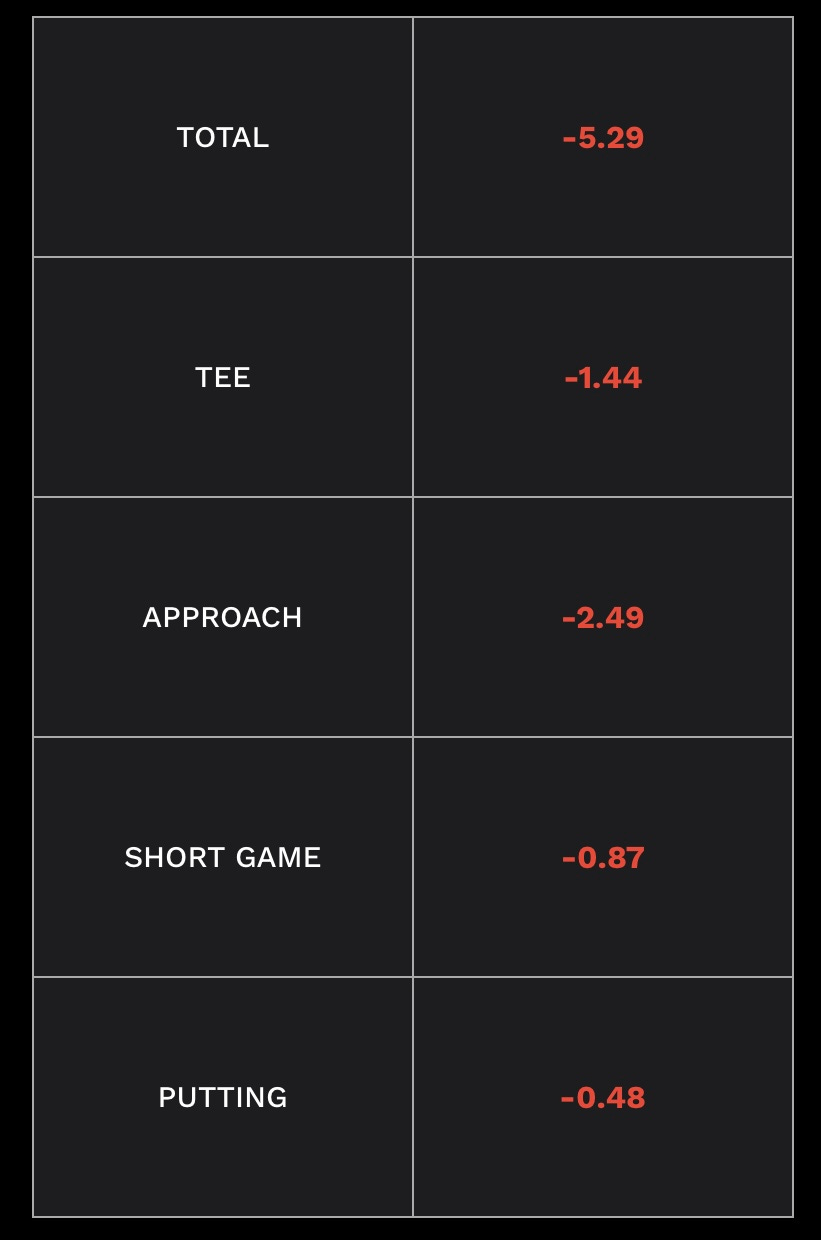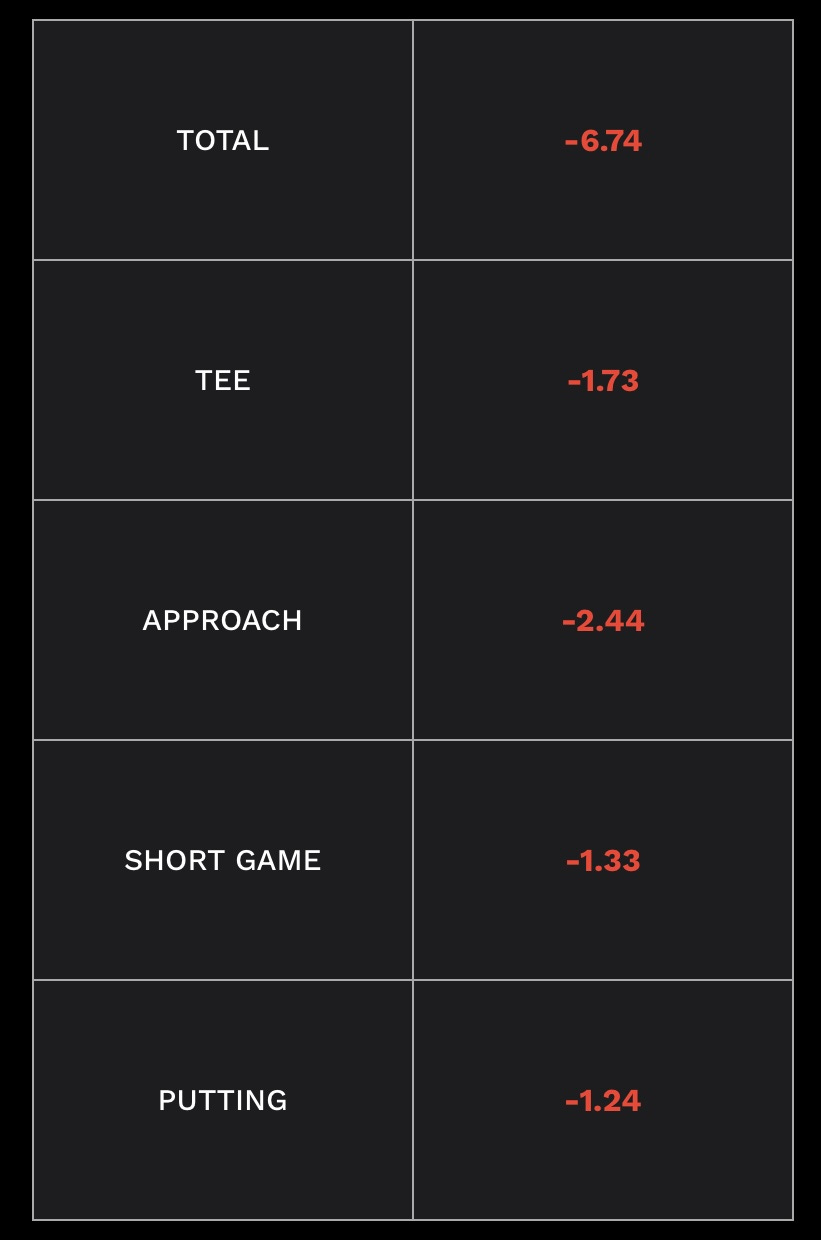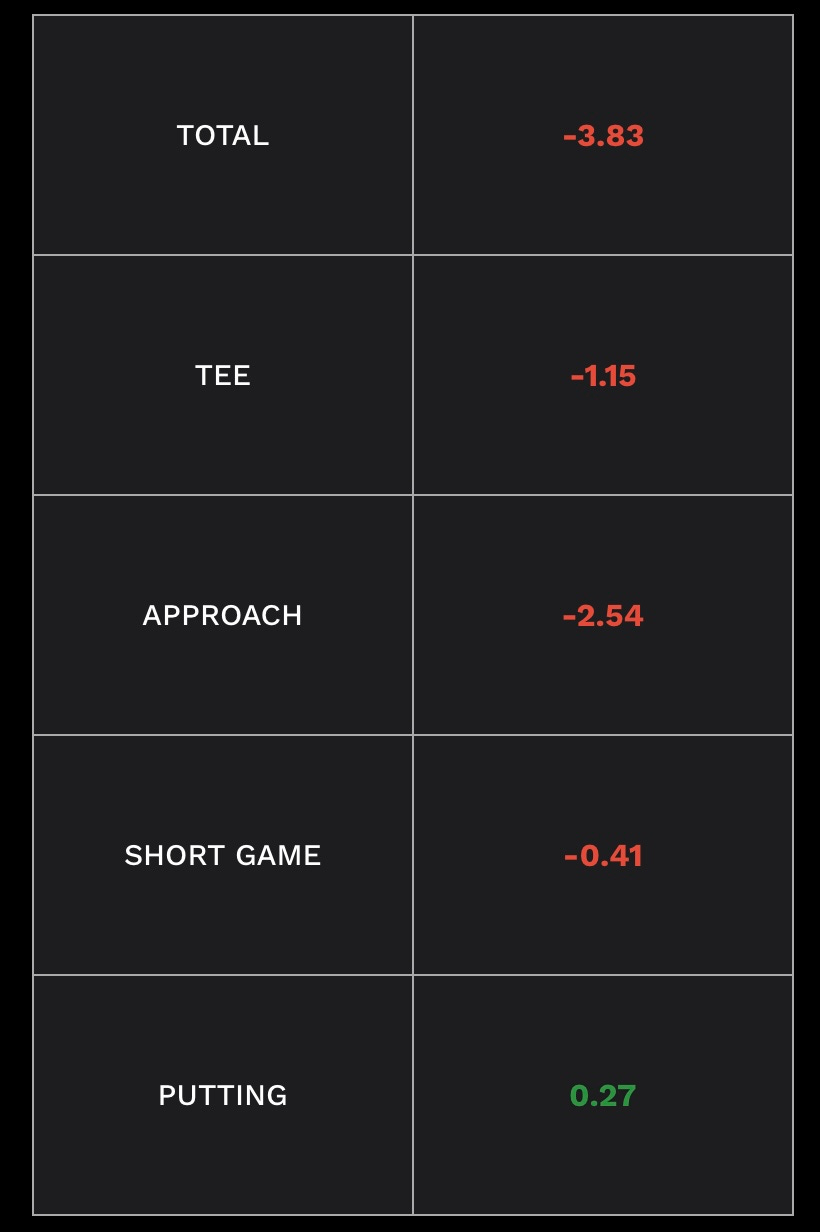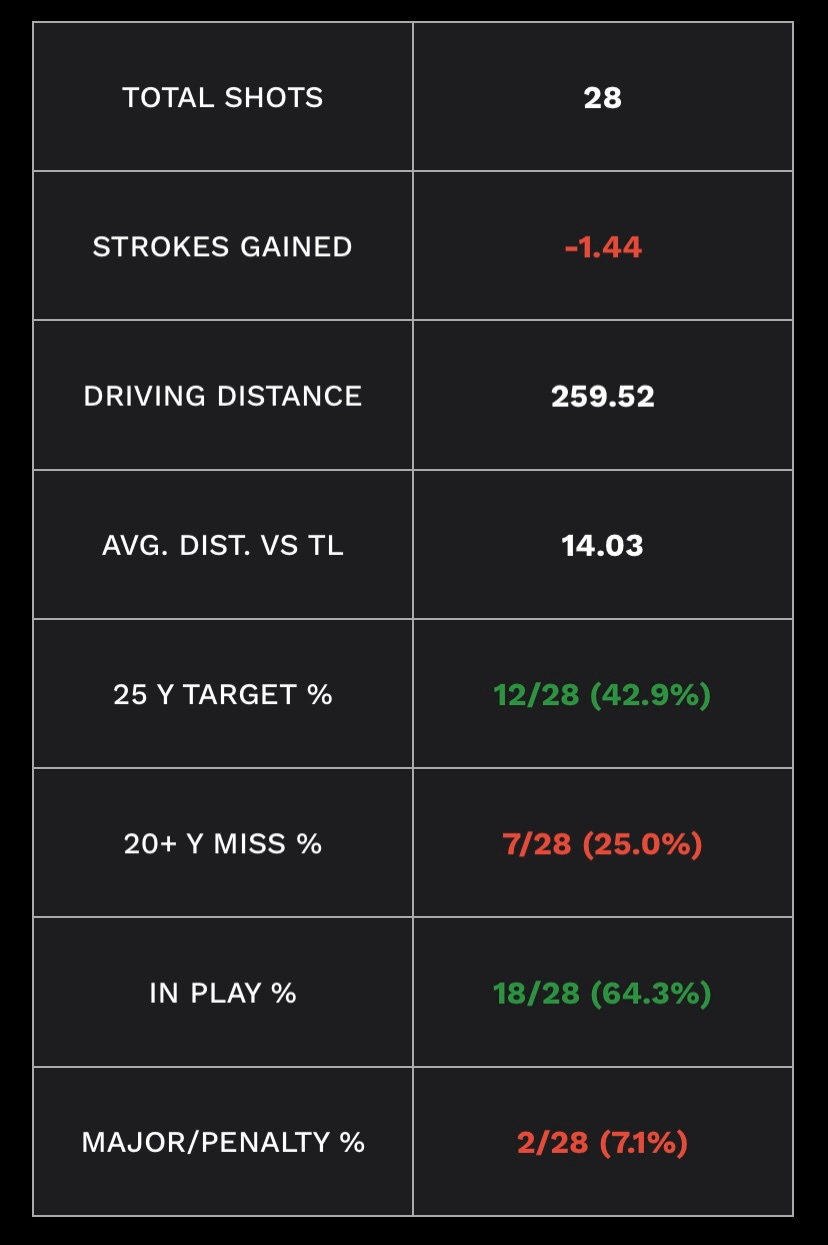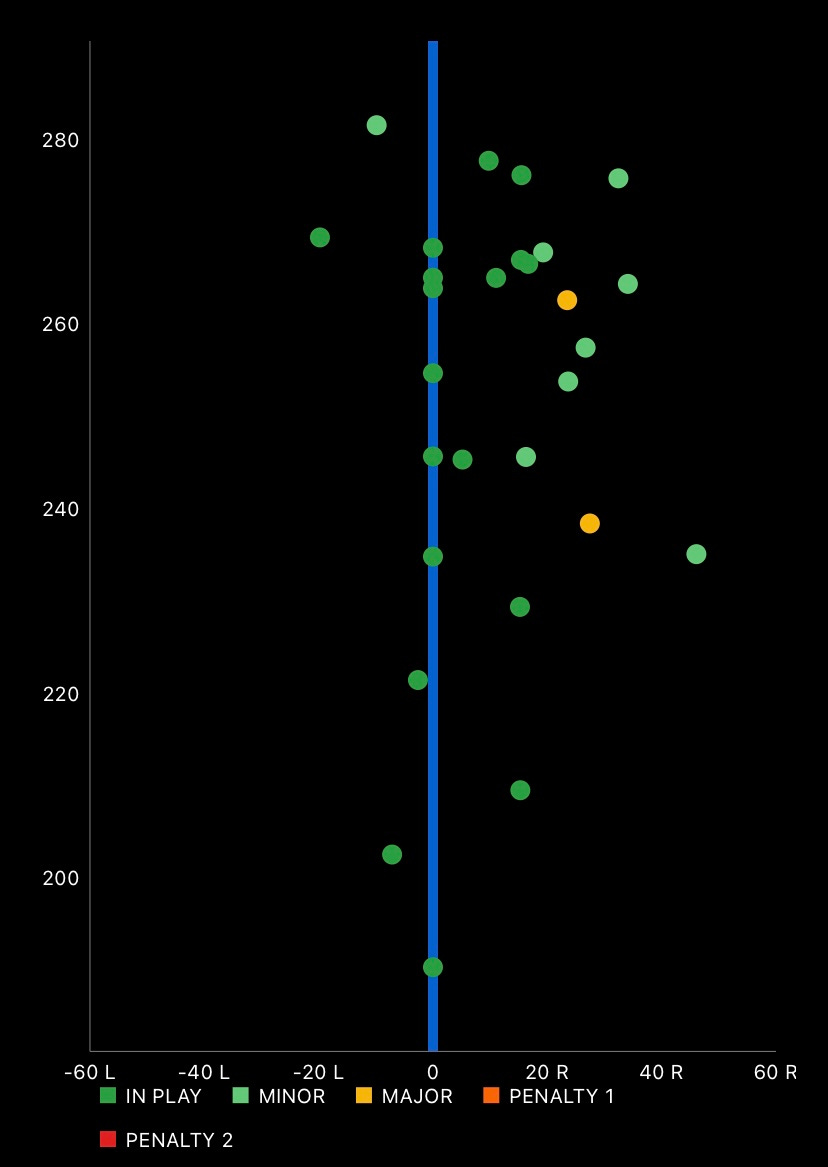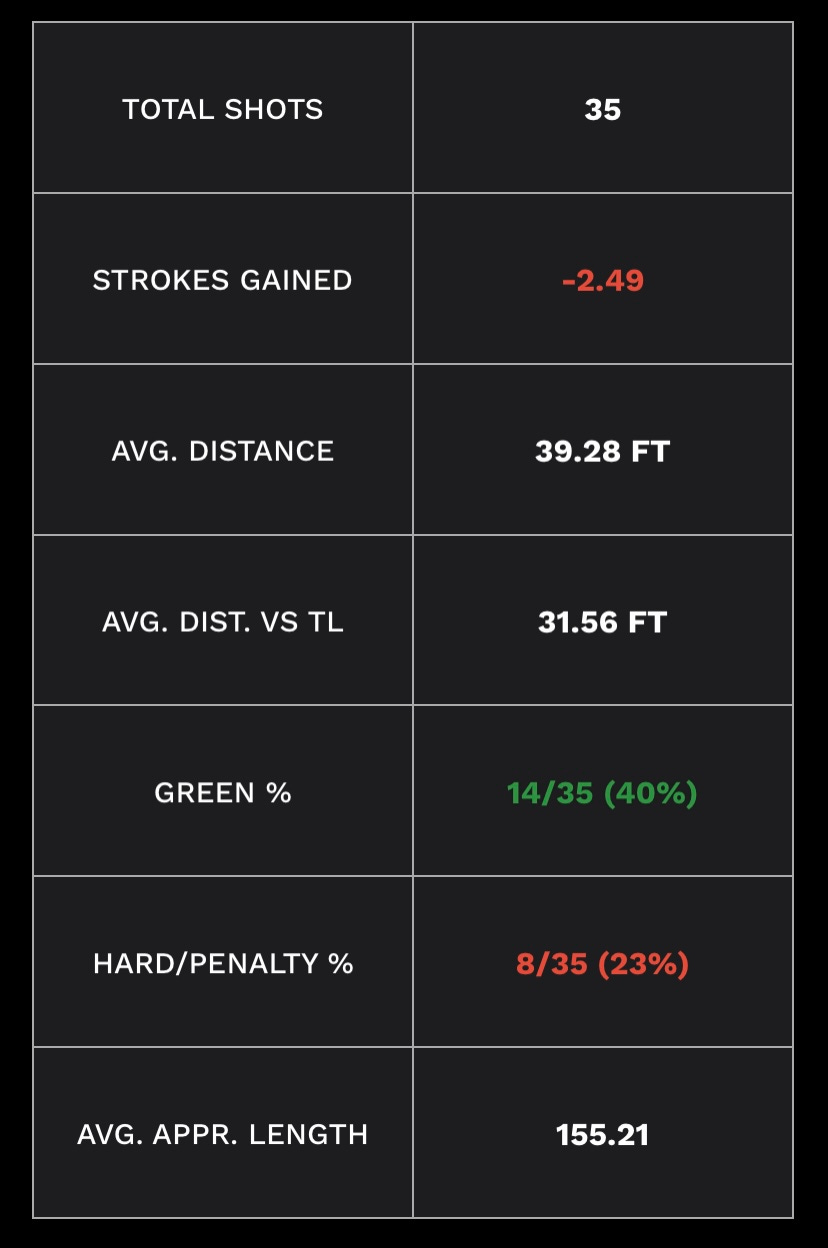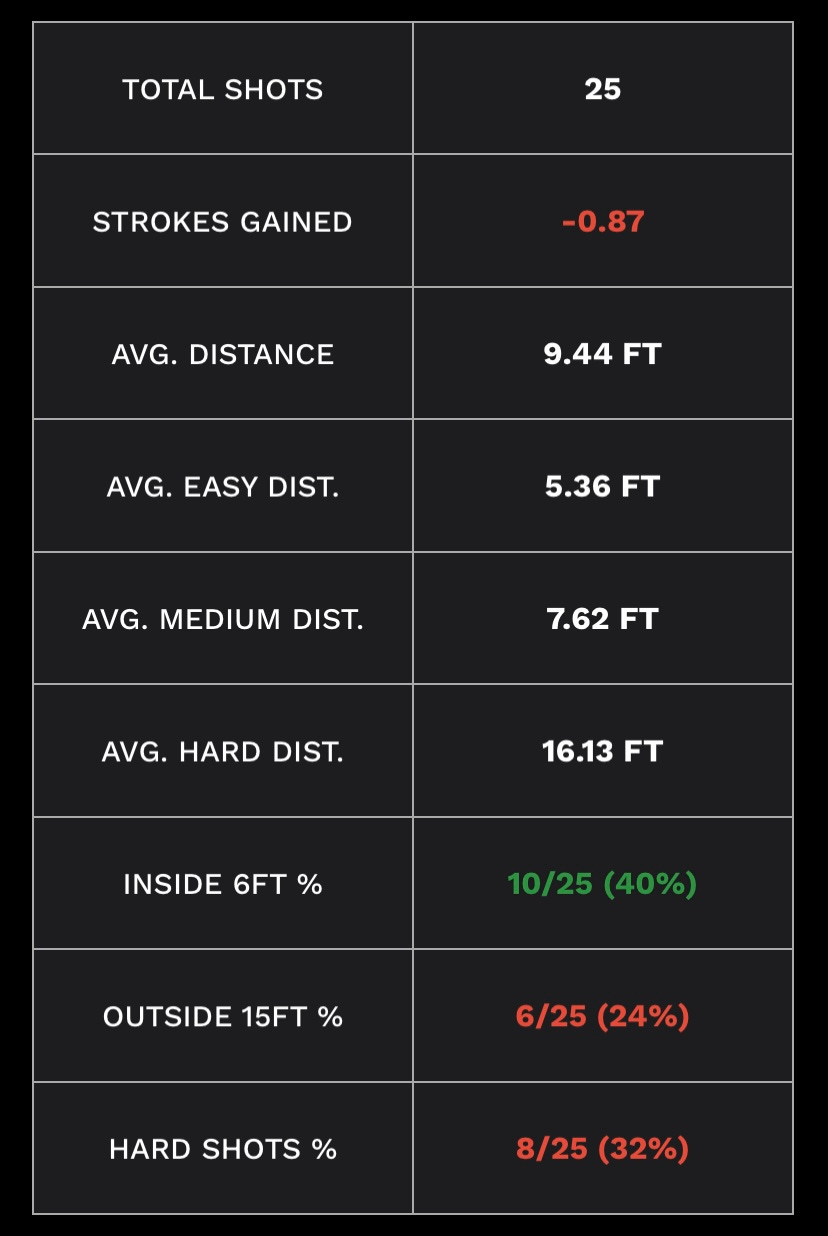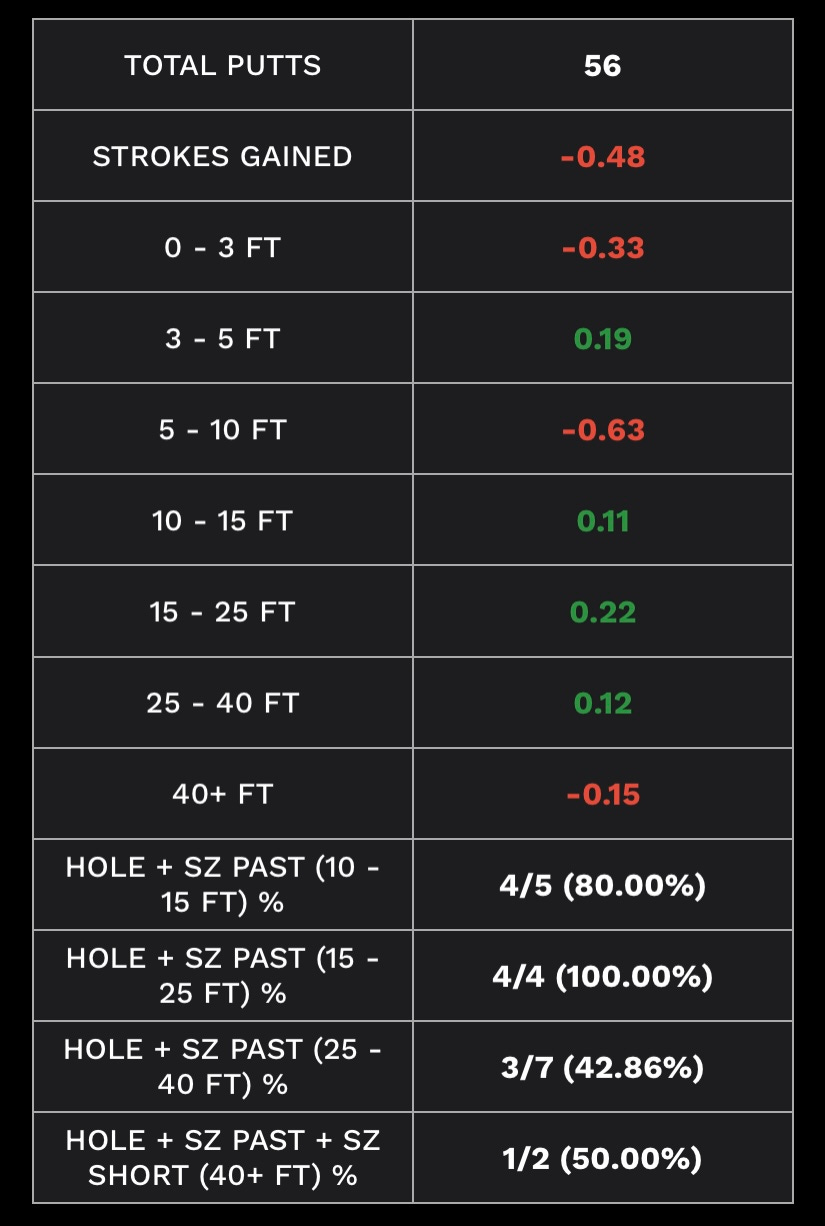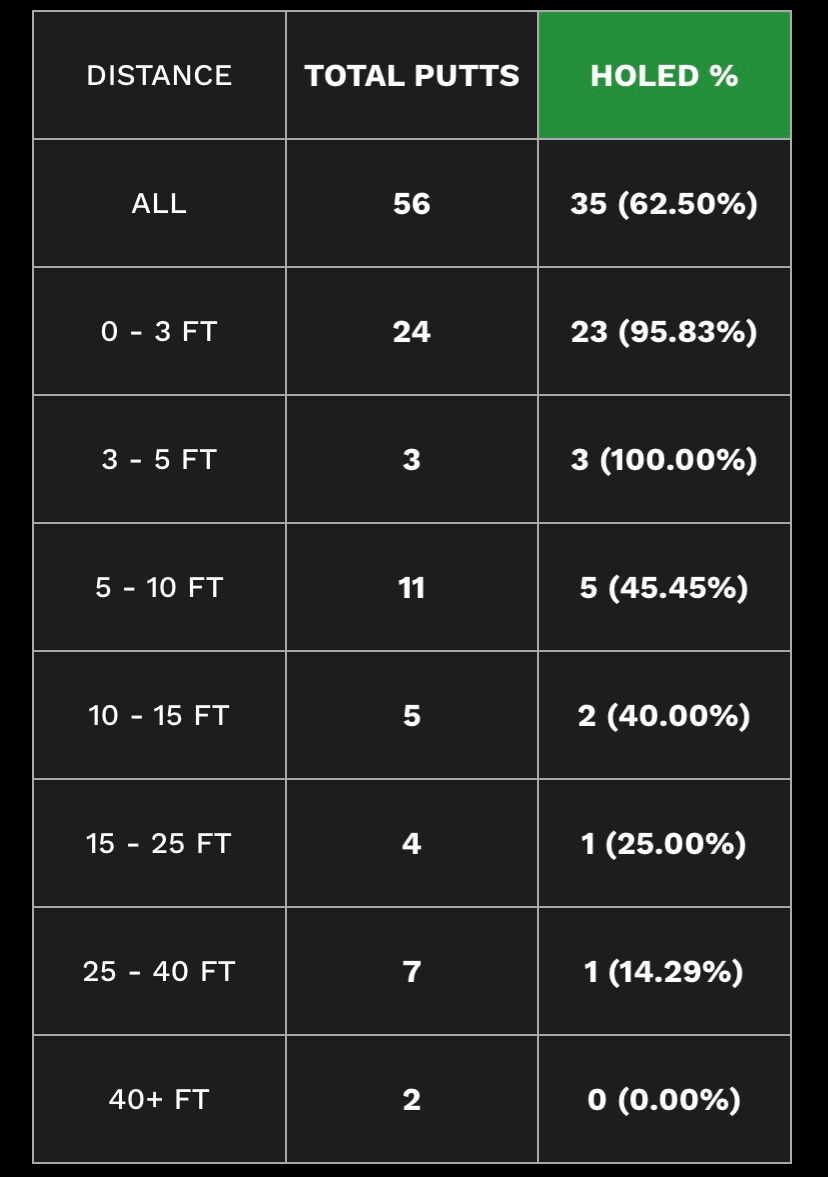This week was a really good reminder that golf can be, in fact, quite hard … at least when you swing the club the way I did on Wednesday and Thursday.
After a rainy Thursday morning and a very windy afternoon, I finished with a 73 in my second round and missed the cut by four shots. A 76 in Round 1 (in good weather) had left me an uphill battle to make the cut … and I couldn’t quite make it happen despite putting up a decent fight in the middle of the second round.
When all was said and done, I moved up about 20 spots on Day 2 and finished in a tie for 86th in a field of 155 players. Certainly not the result I was looking for … but there is good reason to look at this week with a glass half full attitude.
This may have been the worst I’ve swung the golf club over the course of 36 holes in about six months, and it’s definitely the worst I’ve hit my driver and 3-wood off the tee. I’m not totally sure I have the answers for WHY that was the case (I’ll be trying to solve that conundrum over the next few days), but I’m confident Dom and I will get it fixed quickly.
With that said, it is borderline shocking that I was able to at least stay in the mix to make the cut for a while on Thursday DESPITE how I was hitting the ball. My short game was, for the most part, tremendous … and it is further validation of the work I’ve been doing in that area of my game. I played an eleven hole stretch on Day 2 in one-under par in the worst of the conditions (wind was gusting up to 30mph) and had seven straight one-putts during that stretch. I also managed my game much better in the second round despite having little to no idea where the ball was going to go off the club face.
Weeks like this are going to happen and I’ll take a lot away from this one. I was able to watch a handful of really good players (players I aspire to be like) up close and personal and it was a good reminder that I’m not that far off (if at all) talent wise. When I put everything together, I will undoubtedly shoot the scores I need to shoot to play with those guys. Obviously the hard part is putting it all together and remaining consistent over the course of a round, tournament, and season … but I’ll get there.
Big congrats to Michael Kartrude who ended up winning the tournament, shooting 64-70-66 and finishing at 10-under par over the course of the three days. Only eleven guys were under par for the tournament and the scoring average was just under 74 strokes per round.
Rather than do my typical round recap with hole by hole details, I’m going to spare you from having to read “sh*itty drive, blah approach shot, great chip, putt … sometimes another putt” over and over again. Instead, I want to do a deeper dive into my stats over the course of the two rounds and give you a sense for how I look at these to help improve my game. All stats come from Upgame, the stat tracking app I use to track every shot I hit in both competitive and practice rounds.
There are four primary areas that I focus on: Driving (Tee), Approach, Short Game, and Putting. Within those four areas, there are dozens of different ways to break the numbers down to tell the story of how I’m playing.
The most informative stat that best describes the category as a whole is Strokes Gained (I gave an overview of what Strokes Gained is in my Big Hairy Audacious Goals post if you need a refresher). Below is the strokes gained per round summary across the two rounds at the Mass Open (reminder that these numbers are against everyone using the App, NOT against the folks in the Mass Open):
Moving beyond all the red here, it is pretty easy to see the numbers back up what I said about my ball striking (Tee and Approach) being really bad this week. Losing nearly 4 shots per round combined between the two categories is downright awful. And yes, this isn’t against the Mass Open field exactly so the numbers wouldn’t have been quite this bad if it were (I only lost to the average player in the field by 0.5 shots), but it is still informative. On the flipside, that putting number is actually pretty good relative to what its been historically for me and the short game number is slightly misleading because I can guarantee the greens at Longmeadow are more difficult to chip around than the average course Upgame app users are playing on.
When you break it down by round, things get even more interesting. Below are Round 1 and Round 2 strokes gained summaries:
Round 1:
Round 2:
Driving and approach were consistently bad, but in Round 2, I actually GAINED strokes putting and did an even better job of making up for the poor approach play with a good short game. I got slightly better off the tee and slightly worse on approach, which I was actually a bit surprised to see because I felt like I hit my irons a bit better on day two.
Let’s dive into the categories a bit more.
Driving (Tee):
As I mentioned, this is probably the worst I’ve ever driven the ball in a competitive setting. Here is my driving summary for the two rounds:
The first thing that stands out is the driving distance. That number would normally be closer to 280 as an average (including non-driver holes where I’m laying up off the tee), and it’s not like I wasn’t hitting driver in a lot of places. That number directly correlates with the terrible golf swings I was making that led to a number of high and weak shots that missed right of my target.
A quarter of my tee balls missed my target by over 20 yards and 2 of those drives resulted in a “major” miss (which means that I couldn’t go at the green with my next shot). I did get 64% of my tee shots in play with the remaining 8 (28 - 2 majors - 18 in play) ending up as “minor” misses (usually just in the rough but still very playable) … so the majority of my tee balls gave me an opportunity to then go at the green. With that said, I was so far back on many of those holes that I never really had a chance to feel like I had a proper scoring opportunities.
Also informative is the dispersion chart that Upgame can produce. The blue line represents the target and the dots represent the tee shots I hit (not all with drivers, some of the shorter ones were irons off the tee).
It doesn’t take a knowledge of golf or a penchant for data visualization to deduce the trend here. Look at how many dots are right of that target line *(insert mind-blown emoji here)*. This is that “weak right” shot I was describing and I can’t begin to describe how disappointing it was for me not to be able to diagnose the issue leading to that miss as the tournament was going on.
It is obvious what needs to be fixed here and I’ll get that figured out pretty quickly … I just can’t let this happen again.
Approach:
As you saw in the strokes gained summary, approach play wasn’t much better … summary page below:
Hitting only 40% of my greens is bad … and very unlike me. Although there were another six holes where I was on the fringe and putting, so that number is a tiny bit disingenuous. There is no lipstick to put on the stat showing I left myself with 8 hard shots after approach … that means on eight different occasions, I gave myself almost no real opportunity to save par. That is unacceptable over the course of two rounds. Average approach length of 155 yards is not horrible, but it should have been around 130 which is the difference between a wedge and an 8-iron (more likely to hit it closer with a wedge). And leaving myself with nearly 40 feet to the flag on average for birdie makes it highly unrealistic that I will make a lot of putts. All in all, not good.
Dispersion on the approach shots tells a far more muddied story than the tee balls. Remember looking at the tee dispersion shot and having the right misses jump out at you like Todd popping out of Jeremy’s closet with his painting (first person to respond with the movie reference gets a prize), well this one is a bit more like trying to understand the plot of Tenet.
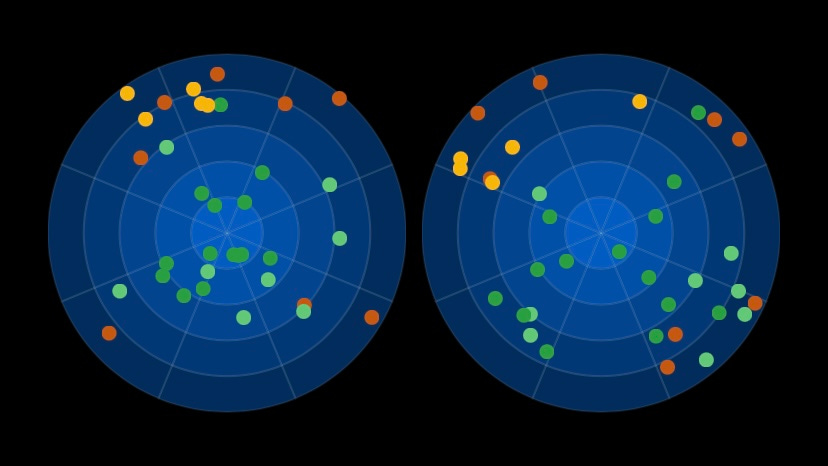
The circle on the left shows my approach shots compared to what my TARGET was and the circle on the right shows those same shots compared to the PIN. The idea here being that I’m not aiming for the pin on every shot, so I can hit a good shot (one in line with the target) without it ending up right on top of the flag.
So what do we see here? Well, first thing I see is not enough shots being hit to pin high or target high. There are too many examples of shots that missed my perfect distance by far too much. Long left was a common miss (and got me into a lot of trouble … notice the red and yellow dots), as was short right. Missing both left and right is tough because I can’t play for that miss as easily as I was able to do so off the tee. That results in the type of poor strokes gained number you saw in the summary.
This is another area that won’t be this bad going forward, but also requires some TLC as I look to improve it to a level that is pro-ready. I struggled again on getting the ball as close as I need to from 125 to 150 yards out (which should be a scoring zone) and that is going to be a big focus of mine over the next few weeks. Dialing in not only my swing, but how I approach shots mentally with wedge, 9-iron, and 8-iron specifically … all scoring clubs.
Short Game:
As I said, I was really happy with my short game this week … but do the numbers back that up? Here is a summary:
The rule of thumb is that I should be able to get “easy” short game shots inside 5 feet, “medium” shots inside 10 feet, and “hard” shots inside 15 feet. Looking at these numbers, I did a pretty good job of hitting those metrics, with a relative outsized performance on those “medium” shots. Longmeadow CC being a Donald Ross course known for its tricky greens make these numbers a little better than they look. The one number here I don’t love is that 6 of those 25 shots ended up outside of that 15-foot range … thought part of that is a high number of nearly impossible shots I left myself during approach.
I just need to keep building on this short game momentum going forward. It’s less about technique at this point and more about constantly improving how I think about the shots I need to hit (looking at the lie, picking the right shot, being creative, etc.).
Putting:
We’ll finish this recap with a bit of a happier story. Putting summary below:
Wait wait wait … is that GREEN I see?!?! About damn time.
The -0.33 strokes gained on putts inside 3 feet is due to a single missed putt from 2 feet after I rushed a tap in late on Wednesday night. Take that away and things look even better. I’m not terribly worried about the 40+ footer category … but what DOES require attention is the 5 to 10 foot category.
I talked about this a little in my Round 1 recap but I hit almost every putt inside 15 feet or so on the exact line I was looking to hit it. Unfortunately, you can hit putts right where you want but misread the putt or get the wrong speed. And in my case, speed was off just a touch on those 10 footers. Over and over I just didn’t hit putts hard enough and they barely missed on the low side.
If we look at the hard conversion numbers, we can see that I missed six total putts in that all important 5 to 10 foot distance.
Take away the performance from 5 to 10 feet and I’m pretty happy with these numbers. Making four putts outside of 10 feet is good compared to where I’ve been previously and the continued success inside of 5 feet is something I’m incredibly proud of because it used to be a big hole in my game and I’ve worked on it a lot.
To recap all of this … I need to hit the ball better and make more putts from outside of 5 feet. Simple, yeah?
On the ball striking front, I have already made massive corrections in the time I finished the Mass Open and when you’ll be reading this. Check out @hazardsascent on Instagram to see some of the improved swings. The next post you’ll see from me will likely be on Tuesday previewing the Mass Amateur Qualifier and then another recapping that next weekend. This is a busy time in my playing schedule, so lots of previews and recaps, but I have a longer lineup of other topics I’m looking forward to sharing with y’all as the schedule eases up a bit.
Big thanks to everyone who has shared their support so far. It means a lot to see the kind words …


